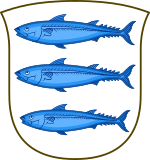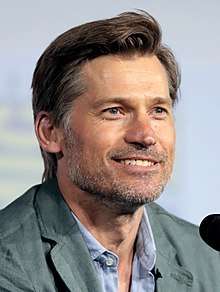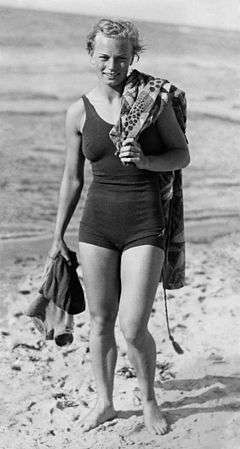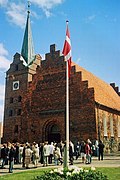Rudkøbing
Rudkøbing (Danish pronunciation: [ˈʁuðˌkʰøˀpe̝ŋ]) is a market town in Denmark. It is the largest town on the island of Langeland, and the municipal seat of Langeland Municipality. It has a population of 4,565 (per 1 January 2020).[1]
History
The first mention of Rudkøbing was in 1287, when it was given market town privileges by Duke Valdemar IV of Schleswig (who held the title of rigsforstander under King Eric VI Menved). During the Count's Feud (1534-1536) and again during the Dano-Swedish War (1658-1660), Rudkøbing was under siege by Swedish troops. Both times, the town's fortifications prevented Rudkøbing from immediately falling, but the town eventually had to give in to the Swedes. The town was hit by the Black Plague during the 16th and 17th centuries, and experienced fires in 1590 and 1610.
The Ørsted family, which most notably includes the brothers Hans Christian and Anders Sandøe Ørsted, has its origins in Rudkøbing. Their father was a pharmacist, and the brothers were born in the old pharmacy on Gåsetorvet. Across from their birth house is a statue of Hans Christian, and a statue of Anders is located at nearby Ørstedsparken, which is named in their honor. The old pharmacy remained in use until 2017.[2][3]
Rudkøbing got its first proper harbor in 1826 (it had previously only had a pier). In 1898, in a town of about 3,500 people, there were 152 ships based in Rudkøbing. Every year, over 2,500 ships (carrying over 18,000 metric tons of cargo) came in and over 2,800 ships (carrying over 11,500 metric tons of cargo) went out, mostly from elsewhere in Denmark. The town was connected by steam ferry routes to Copenhagen, Korsør, Marstal, and Svendborg.
The town's population was stable during the Interwar period, hovering above 4,000, with the census in 1930 showing a population of 4,129. The population peaked at 4,541 in 1950, and by 1965, it had fallen to 4,204. Around this time a suburb developed in Skrøbelev Parish, which eventually grew together with Rudkøbing.
Each year since 1991, the town has hosted Langelandsfestivalen, a music festival which targets families and older people (unlike the larger Roskilde Festival elsewhere in Denmark, which is mostly attended by young people).[4]

Rudkøbing was the seat of the former Rudkøbing Municipality in Funen County, and is the seat of the current Langeland Municipality in the Southern Denmark Region. When Rudkøbing was its own municipality, there were often negotiations with the two other Langelandic municipalities of Sydlangeland and Tranekær to merge. These plans were repeatedly abandoned due to a lack of public support. In the Structure Reform of 2007, the three were forced together, and Rudkøbing has since been the municipal seat.
Transport
Bridges connecting Rudkøbing and Svendborg were built throughout the late 1950s and early 1960s, finishing in 1966. The old ferry route between the two towns gradually lost popularity due to the bridges, and the route was eventually ended. The ferry route to Marstal, which had been active since 1866, was closed in 2013, so that the only ferry on this route could be moved to the busy route between Marstal and Svendborg. The ferry route between Rudkøbing and Marstal opened again in December 2019.
The Langeland Bridge was built between 1960 to 1962. It connects Rudkøbing and the rest of Langeland to the island of Siø. Siø is further linked by the Siøsund Bridge to Tåsinge, and Tåsinge is linked by the Svendborgsund Bridge to Svendborg on the mainland of Funen, making Rudkøbing accessible by road.[5]
From 1911 to 1962, Rudkøbing was the main station of the Langeland rail network (Langelandsbanen). The network was connected to Svendborg in 1926, when a railway ferry route made it possible to move train wagons between Rudkøbing and the mainland of Funen.[6]
Notable people



Artists
- Jens Christian Bay (1871 in Rudkøbing – 1962), Danish American writer, bibliographer and librarian, who emigrated to the US in 1892.[7]
- Preben Lerdorff Rye (1917 in Rudkøbing – 1995), actor who appeared in 92 films [8]
- Bjørn Watt Boolsen (1923 in Rudkøbing – 1998), actor who played several characters in the Olsen-banden films.[9]
- Nikolaj Coster-Waldau (born 1970 in Rudkøbing), actor, who played Jaime Lannister in the TV series Game of Thrones.[10]
Athletes
- Ingrid Larsen (1912 in Rudkøbing – 1997), diver who competed in the 1932 Summer Olympics.
- Hans Jørgen Boye (born 1942 in Rudkøbing) retired rower, competed in the 1964 Summer Olympics.
In history
- Gertrud Skomagers (died 1556), who was accused by Hans Ipsen in Rudkøbing of being a witch. The case led to a change in the law regarding witch trials in Denmark.
- Erik Bredal (1608 in Rudkøbing – 1672), Danish-born Norwegian Lutheran bishop.[11]
- Anders Sandøe Ørsted (1778 in Rudkøbing – 1860), politician and jurist, who served as Prime Minister of Denmark 1853-1854 [12]
- Mads Lange, (1807 in Rudkøbing – 1856 in Kuta, Dutch East Indies), nicknamed the King of Bali , Danish trader, entrepreneur, and peace maker on Bali. Several of his descendants, including Crown Prince Tunku Abu Bakar of Johor, visited Rudkøbing in 2011.[13][14]
- Erik Larsen, (born 1944 in Rudkøbing) politician from the Liberal Party. Mayor of Egebjerg Municipality 1978-1986, and member of the Folketing 1987-2005.
Scientists
- Otto Fabricius (1744 in Rudkøbing – 1822), missionary, naturalist, ethnographer, and explorer of Greenland.[15]
- Hans Christian Ørsted (1777–1851), physicist and chemist who discovered that electric currents create magnetic fields, known for Oersted's law [16]
- Anders Sandøe Ørsted (1816 in Rudkøbing – 1872), botanist, mycologist, zoologist and marine biologist.[17] [18]
Gallery
 Closeup of the Ørsted statue on Gåsetorvet.
Closeup of the Ørsted statue on Gåsetorvet. Map of Rudkøbing in 1900. Note the archaic spelling of the town's name.
Map of Rudkøbing in 1900. Note the archaic spelling of the town's name.- The Langeland Bridge, as seen from Rudkøbing.
- The old railway station in Rudkøbing.
 Rudkøbing Church.
Rudkøbing Church.
References
- BY3: BEF44: Population 1st January, by urban areas The Mobile Statbank from Statistics Denmark
- "Hans Christian Ørsted". academictree.org. Retrieved January 1, 2020.
- "Ørsted, Anders Sandøe, 1778-1860". Dansk biografisk Lexikon. Retrieved January 1, 2020.
- "Langelandsfestival". langelandsfestival.dk. Retrieved January 1, 2020.
- "Langeland Bridge". Structurae Version. Retrieved January 1, 2020.
- "Langelandsbanen". jernbanen.dk. Retrieved January 1, 2020.
- Niels Alsted, Svend Dahl. "J. Christian Bay". Dansk Biografisk Leksikon, Gyldendal. Retrieved January 1, 2020.
- Preben Lerdorff Rye (1917–1995) from IMDb, retrieved 28 January 2019
- Bjørn Watt-Boolsen (1923–1998) from IMDb, retrieved 28 January 2019
- Nikolaj Coster-Waldau from IMDb, retrieved 28 January 2019
- Helle, Knut (ed.). "Erik Bredal". Norsk biografisk leksikon. Retrieved January 1, 2020.
- The Encyclopedia Americana, Oersted, Anders Sandöe, retrieved 24 April 2020
- https://www.fyens.dk/langeland/Kongelige-besoegte-i-Rudkoebing/artikel/1883378
- "Mads Johansen Lange From Denmark to Bali, Indonesia". tourguidesbali.com/. Retrieved January 1, 2020.
- Tarald Rasmussen. "Otto Fabricius". Store norske leksikon. Retrieved January 1, 2020.
- The Encyclopedia Americana, Oersted, Hans Christian, retrieved 24 April 2020
- "Ørsted, Anders Sandøe, 1816-72, Botaniker". Dansk biografisk Lexikon. Retrieved January 1, 2020.
- Appletons' Cyclopædia of American Biography, Oersted, Anders Sandöe, retrieved 24 April 2020